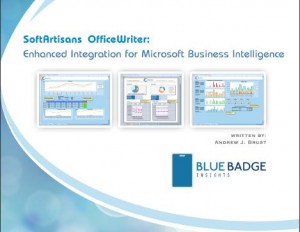 [Click here to read the full review!]
[Click here to read the full review!]
To many of you, the name Andrew Brust might ring a bell. After all, this is a man who’s been working with, shaping and talking about Microsoft technologies for twenty years. Maybe you’ve seen him speak or read his columns on Visual Studio Magazine and Redmond Developer News. Maybe you’ve heard of his new Microsoft consulting firm, Blue Badge Insights. Maybe, like me, you follow his personal blog. I started reading Brust Blog in the beginning of the year, and it quickly became my de facto source for objective analysis of Microsoft developments. A few comments led to an email exchange that, a few months later, lead to what has got to be one of the most cogent and comprehensive summaries of an advanced technological product out there.
Coming up with an elevator pitch for OfficeWriter (particularly one geared towards the non-developer) isn’t necessarily the easiest thing to do, but Andrew managed to do it in the first sentence:
SoftArtisans’ OfficeWriter takes Microsoft’s Excel and Word and transforms them from mere spreadsheet and word processing applications into full-fledged data presentation and Business Intelligence delivery platforms.
He then proceeds to tackle the why of OfficeWriter—why it does what it does, and why it’s needed. OfficeWriter is a server-generated, Office-format reporting solution, and the reports are in Office, rather than HTML or PDF, because that’s what business-users and developers can use. There is a need for OfficeWriter because none of Microsoft’s own Office reporting methods (the Office import facilities, VBA, VSTO and the Open XML API) “provides the full range of features, file format-compatibility and server side performance.”
What these features are is addressed in the next part of the review, starting with OfficeWriter’s use as a developer tool that allows for both the imperative “YAFIYGI” and declarative “WYSIWYG” approaches to programming.
The YAFIYGI approach is geared to developers who prefer to integrate application data into a document through explicit commands that govern the data’s placement. The WYSIWYG approach instead allows OfficeWriter to take an existing document and insert specific data items at specific positions within it.
OfficeWriter’s SQL Server Reporting Services integration is covered next, explained as a faster, safer and professional alternative to the Excel spreadmart phenomenon. Used in conjunction with SQL Server Reporting Services, OfficeWriter lets users design SSRS reports in Excel and Word or in the VS-based report designer or Report Builder, then pass all the queries, rendering and delivery of subscriptions back to SSRS.
Your production databases can be used as they would be from a conventional SSRS report, but you gain access to the data visualization and analysis features of Excel, the layout and pagination features of Word and the added relevancy to users of delivering reports as Office documents.
The review wraps up by making a case for OfficeWriter’s ROI: empowering a business to take raw corporate data and process it in a way that is understandable and actionable to all its participants. OfficeWriter’s value-enhancing functionality makes the product an example of “why the partner environment is called an ‘ecosystem.”
If my meta-review is leaving you hungry for the real thing, you can read (and download) it here. We’re very grateful to Andrew for all the work he’s put into this, and for the end result, so by all mean, share away!
Share the post "Andrew Brust on OfficeWriter: “Enhanced Integration for Microsoft Business Intelligence”"
 Follow
Follow